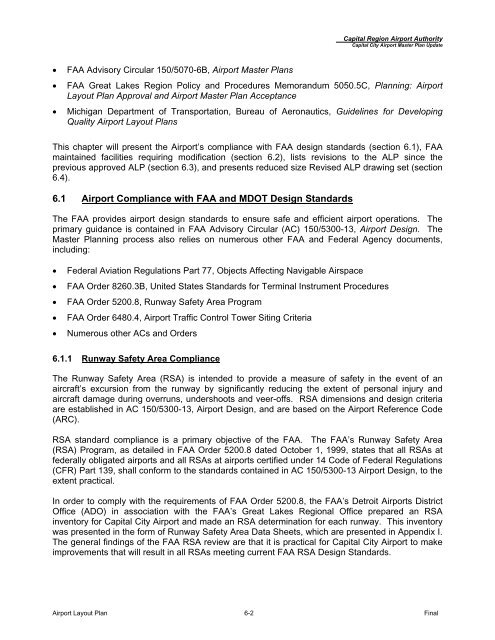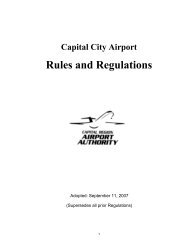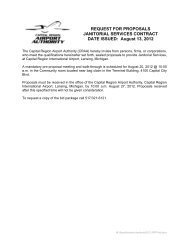Master Plan Update (pdf) - Lansing/Capital City Airport
Master Plan Update (pdf) - Lansing/Capital City Airport
Master Plan Update (pdf) - Lansing/Capital City Airport
Create successful ePaper yourself
Turn your PDF publications into a flip-book with our unique Google optimized e-Paper software.
• FAA Advisory Circular 150/5070-6B, <strong>Airport</strong> <strong>Master</strong> <strong>Plan</strong>s<br />
<strong>Capital</strong> Region <strong>Airport</strong> Authority<br />
<strong>Capital</strong> <strong>City</strong> <strong>Airport</strong> <strong>Master</strong> <strong>Plan</strong> <strong>Update</strong><br />
• FAA Great Lakes Region Policy and Procedures Memorandum 5050.5C, <strong>Plan</strong>ning: <strong>Airport</strong><br />
Layout <strong>Plan</strong> Approval and <strong>Airport</strong> <strong>Master</strong> <strong>Plan</strong> Acceptance<br />
• Michigan Department of Transportation, Bureau of Aeronautics, Guidelines for Developing<br />
Quality <strong>Airport</strong> Layout <strong>Plan</strong>s<br />
This chapter will present the <strong>Airport</strong>’s compliance with FAA design standards (section 6.1), FAA<br />
maintained facilities requiring modification (section 6.2), lists revisions to the ALP since the<br />
previous approved ALP (section 6.3), and presents reduced size Revised ALP drawing set (section<br />
6.4).<br />
6.1 <strong>Airport</strong> Compliance with FAA and MDOT Design Standards<br />
The FAA provides airport design standards to ensure safe and efficient airport operations. The<br />
primary guidance is contained in FAA Advisory Circular (AC) 150/5300-13, <strong>Airport</strong> Design. The<br />
<strong>Master</strong> <strong>Plan</strong>ning process also relies on numerous other FAA and Federal Agency documents,<br />
including:<br />
• Federal Aviation Regulations Part 77, Objects Affecting Navigable Airspace<br />
• FAA Order 8260.3B, United States Standards for Terminal Instrument Procedures<br />
• FAA Order 5200.8, Runway Safety Area Program<br />
• FAA Order 6480.4, <strong>Airport</strong> Traffic Control Tower Siting Criteria<br />
• Numerous other ACs and Orders<br />
6.1.1 Runway Safety Area Compliance<br />
The Runway Safety Area (RSA) is intended to provide a measure of safety in the event of an<br />
aircraft’s excursion from the runway by significantly reducing the extent of personal injury and<br />
aircraft damage during overruns, undershoots and veer-offs. RSA dimensions and design criteria<br />
are established in AC 150/5300-13, <strong>Airport</strong> Design, and are based on the <strong>Airport</strong> Reference Code<br />
(ARC).<br />
RSA standard compliance is a primary objective of the FAA. The FAA’s Runway Safety Area<br />
(RSA) Program, as detailed in FAA Order 5200.8 dated October 1, 1999, states that all RSAs at<br />
federally obligated airports and all RSAs at airports certified under 14 Code of Federal Regulations<br />
(CFR) Part 139, shall conform to the standards contained in AC 150/5300-13 <strong>Airport</strong> Design, to the<br />
extent practical.<br />
In order to comply with the requirements of FAA Order 5200.8, the FAA’s Detroit <strong>Airport</strong>s District<br />
Office (ADO) in association with the FAA’s Great Lakes Regional Office prepared an RSA<br />
inventory for <strong>Capital</strong> <strong>City</strong> <strong>Airport</strong> and made an RSA determination for each runway. This inventory<br />
was presented in the form of Runway Safety Area Data Sheets, which are presented in Appendix I.<br />
The general findings of the FAA RSA review are that it is practical for <strong>Capital</strong> <strong>City</strong> <strong>Airport</strong> to make<br />
improvements that will result in all RSAs meeting current FAA RSA Design Standards.<br />
<strong>Airport</strong> Layout <strong>Plan</strong> 6-2 Final




